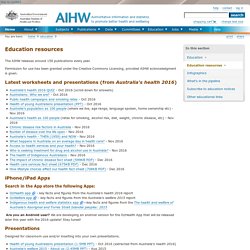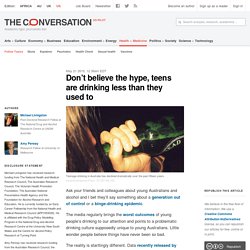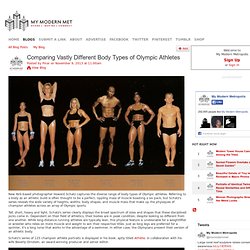

Education resources. The AIHW releases around 150 publications every year.

Permission for use has been granted under the Creative Commons Licensing, provided AIHW acknowledgment is given. Latest worksheets and presentations (from Australia's health 2016) iPhone/iPad Apps Search in the App store the following Apps: OzHealth app - key facts and figures from the Australia's health 2016 reportOzWelfare app - key facts and figures from the Australia's welfare 2015 report Indigenous health and welfare statistics app—key facts and figures from the The health and welfare of Australia’s Aboriginal and Torres Strait Islander peoples: 2015 Are you an Android user?
Presentations Designed for classroom use and/or inserting into your own presentations. Videos What is burden of disease? Quizzes See below for Quiz answers. Infographics, posters and report profiles Infographics present complex information in a way that is visually stimulating and easily understandable. Resources by subject area. Education resources. Simple Guidelines on Children Involved in Weight Training – Renaissance Periodization. 23 and 1/2 hours. Don't believe the hype, teens are drinking less than they used to. Ask your friends and colleagues about young Australians and alcohol and I bet they’ll say something about a generation out of control or a binge-drinking epidemic.

The media regularly brings the worst outcomes of young people’s drinking to our attention and points to a problematic drinking culture supposedly unique to young Australians. Little wonder people believe things have never been so bad. The reality is startlingly different. Data recently released by the Australian Bureau of Statistics shows alcohol consumption in Australia has reached its lowest point since the early 1960s, having declined steadily since the mid-2000s.
Survey data suggests this decline has been driven almost entirely by reductions in youth drinking. According to the National Drug Strategy Household Survey, the proportion of 12- to 15-year-olds who reported any drinking in the past year halved, from 35% in 2004 to 18% in 2013. Rates of heavy drinking have fallen as well.
HSC PDHPE. Exam and Assessments - How To.. AIS Home. The Biomechanics Of Usain Bolt. Cristiano Ronaldo - Tested To The Limit. Comparing Vastly Different Body Types of Olympic Athletes. New York-based photographer Howard Schatz captures the diverse range of body types of Olympic athletes.

Referring to a body as an athletic build is often thought to be a perfect, rippling mass of muscle boasting a six pack, but Schatz's series reveals the wide variety of heights, widths, body shapes, and muscle mass that make up the physiques of champion athletes across an array of Olympic sports. Tall, short, heavy and light, Schatz's series clearly displays the broad spectrum of sizes and shapes that these disciplined jocks come in. Dependent on their field of athletics, their bodies are in peak condition, despite looking so different from one another. While long-distance running athletes are typically lean, this physical feature is undesirable for a weightlifter or wrestler who relies on more muscle and weight to win their respective titles.
Just as long legs are preferred for a sprinter, it's a long torso that works to the advantage of a swimmer. The Men Who Made Us Fat ''Episode 1/3'' The Men Who Made Us Fat ''Episode 2/3'' The Men Who Made Us Fat ''Episode 3/3'' What does it mean to have an athletic body? Autumn over at The Beheld wrote a post yesterday entitled “On Athletic Bodies,” and I found it very thought-provoking.

Here’s the meat of her post (although I think you should read the whole thing anyway, and in fact, you should probably just go ahead and put her blog into your RSS reader while you’re at it): So the first time I saw “athletic body” in the “dress your figure” pages of a women’s magazine, I got excited. Finally, someone was acknowledging that not all women who work out are doing so to lose weight—and, hey, maybe I’d finally, once and for all, learn what kind of figure I actually had.
But when the advice focused on “creating curves,” I was confused: I’m not particularly busty, but lacking curves has never been my problem. In fact, since muscles generally are not shaped like squares but instead are gently sloping, I probably have more curves than I did before I started lifting weights.All the arguments I’ve made before about “dressing for your figure” apply to “athletic.” Stage 6 PDHPE. Preliminary HSC PDHPE Core 2.